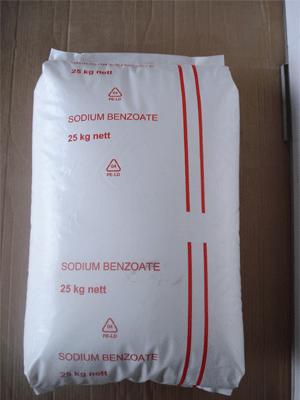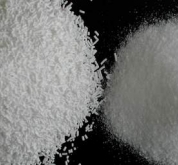Support online
Statistics Hits
Follow us

Sodium Benzoate (USA)
Sodium benzoate has NaC6H5CO2 chemical formulas, it is widely used food preservative, with the EE211. It is the sodium salt of benzoic acid and exists in this form when dissolved in water. It can be produced from the reaction of sodium hydroxide with benzoic acid.
Use
Sodium benzoate is a preservative. It is bacterial and fungistatic under acidic conditions. It is widely used in foods like salad acidic (vinegar), carbonated beverages (carbonic acid), jams and juice (citric acid), pickles (vinegar), and Family location. It is also used as a preservative in drugs and cosmetics. [1] [2] As a food additive, sodium benzoate has E number E211.
It is also used in fireworks as a fuel in whistle mix, a powder emits a whistling sound when squeezed into a tube and ignited. Fuel is one of the burning rocket fuel fastest and provide a lot of thrust and smoke. It does have its downside: there is a high risk of explosion when the fuel is compressed sharply because of the sensitivity of the impact of fuel.
Sodium benzoate is produced by neutralization with sodium hydroxide benzoic acid. [3] Benzoic acid was detected in southern Vietnam lows blueberries, plum, greengage plums, cinnamon, ripe cloves, and apples. Although benzoic acid is an effective preservative, sodium benzoate is commonly used as a food additive because benzoic acid insoluble in water. [3] Focus as a preservative is restricted by the US FDA to 0.1% by weight. International Programme on Chemical Safety found no adverse effects in humans at doses of 647-825 mg / kg body weight per day. [4] [5]
Cats have a significantly lower tolerance than benzoic acid and its salts than rats and mice. [6] Sodium benzoate is, however, allowed as a food additive animal up to 0.1%, according to the AFCO ++++ s [designate officially announced. 7]
Mechanism of food preservation
The mechanism starts with the absorption of benzoic acid into the cell. If the intracellular pH changes to 5 or lower, the anaerobic glucose through phosphofructokinase lenmen were reduced by 95%, [8] thus inhibits the growth and survival of microorganisms that cause food spoilage.
Safety and health
Posts: Benzene in soft drinks
In combination with ascorbic acid (vitamin C, E300), sodium benzoate and potassium benzoate form benzene, a known carcinogen thuduoc. However, in almost all beverages that contain both benzene levels below those considered to be dangerous to consume. [9] Heat, light and shelf life can affect the rate of benzene is formed.
Professor Peter W. Piper of Sheffield University confirmed that sodium benzoate by itself can damage and inactivate the important parts of the DNA of a cell mitochondria. Mitochondria consume oxygen to produce ATP, the energy currency of the body. If they are damaged by the disease, dysfunction can enter cells and apoptosis. [Citation needed]
Hyperactivity
Research published in 2007 by the Food Standards Agency (FSA) shows that certain artificial colors, when combined with sodium benzoate (E211) may be linked to hyperactive behavior. The result is not suitable for sodium benzoate, so the FSA suggest further research. [10] [11] [12]
Professor Jim Stevenson from Southampton University, and author of the report, said: "This is a major study investigating an important area of study results showed that consumption of certain mixtures of true colors Is artificial and sodium benzoate preservative are associated with increases. hyperactive behavior in children, however, parents should not think that simply taking the food additive will prevent disorder hyperactive. We know that many other influences at work but this at least is one a child can avoid. " [twelfth]
The two mixtures of additives tested in the study: [12]
Mix A:
Sunset yellow (E110)
Tartrazine (E102)
Carmoisine (E122)
Ponceau 4R (E124)
Sodium benzoate (E211)
Mix B:
Sunset yellow (E110)
Quinoline yellow (E104)
Carmoisine (E122)
Allura red (E129)
Sodium benzoate (E211)
Sodium benzoate was included in both the mixture, but the effects observed are not consistent. Therefore, the Food Standards Agency said that if true, the behavior observed increase hyperactive are more likely to be associated with one or more specific colors tested.
April 10, 2008, the Food Standards Agency is called a voluntary removal of color (but not sodium benzoate) in 2009. [13] In addition, it recommended that there should be action stage them in food and beverages in the European Union (EU) during the period specified. [14]
In response to assert consumers about a product's natural and E211 linked to DNA damage and ADHD, the Coca Cola Company is in the process of phasing Benzoate Sodium Diet Coke. The company has stated that it plans to remove E211 from its other products - including Sprite, Fanta, and Oasis - immediately after discovering a satisfactory alternative [15]












